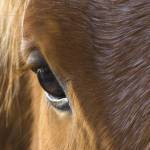Eye Wrinkles in Horses: A Measure of Well-Being

Horses frequently rely on subtle cues to communicate with herdmates and humans. Simply turning their body a few degrees, flicking an ear, nickering softly—all of these subtle actions speak volumes. According to a recent study*, even the way a horse wrinkles his eyebrows tells a story regarding his emotional well-being, prompting researchers to suggest that the eyes are the mirror of the soul.
As described in the article, Charles Darwin suggested that humans and animals are both able to express their state of mind through movements, and that facial expressions could indicate emotions. This theory is already being explored using the grimace scale for pain in horses.
Eye wrinkles, caused by contraction of the inner eyebrow raiser muscles, are thought to convey pain or a negative emotional state. To determine if this theory is true, Hintze and coworkers recruited 16 horses and exposed them to two positive (grooming, food anticipation) and two negative (food competition, waving a plastic bag) conditions. Horses were photographed during the study, and six factors were assessed: eyelid shape, markedness of eye wrinkles, presence of white eye, qualitative assessment of the eye, number of wrinkles, and angle.
This preliminary study found that those six measures reliably permitted assessment of eye-wrinkle expression. For example, the angle was narrower when the muscles were relaxed during grooming but larger when the muscles were contracted during food competition.
Ocular health is important not only for serving as a potential welfare indicator but also overall comfort, considering horses are prey animals and heavily reliant on vision to survive.
The researchers used food competition as a negative condition in this study. To counteract any effect of stress on the digestive system, consider supplementing with RiteTrac, a proprietary blend of ingredients designed to support total digestive tract health. Targeted to benefit the stomach and the hindgut of the horse, RiteTrac works in two distinct ways. First, with its combination of fast-acting antacids and coating agents, RiteTrac quickly neutralizes excess gastric acid, protecting the stomach lining and restoring the normal gastric environment. Second, RiteTrac contains EquiShure, a time-released hindgut buffer designed to act in the cecum and colon by maintaining optimal pH, thereby reducing the risk of hindgut acidosis.
RiteTrac and EquiShure are available in the U.S. and other areas. Australian horse owners should look for EquiShure and other research-proven products.
*Hintze, S., S. Smith, A. Patt, et al. 2016. Are eyes a mirror of the soul? What eye wrinkles reveal about a horse’s emotional state. PLoS One. 11(10):e0164017.








